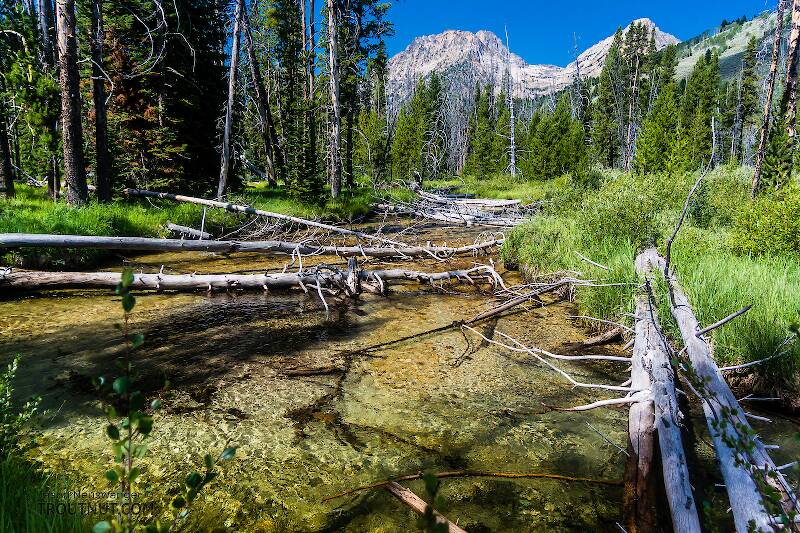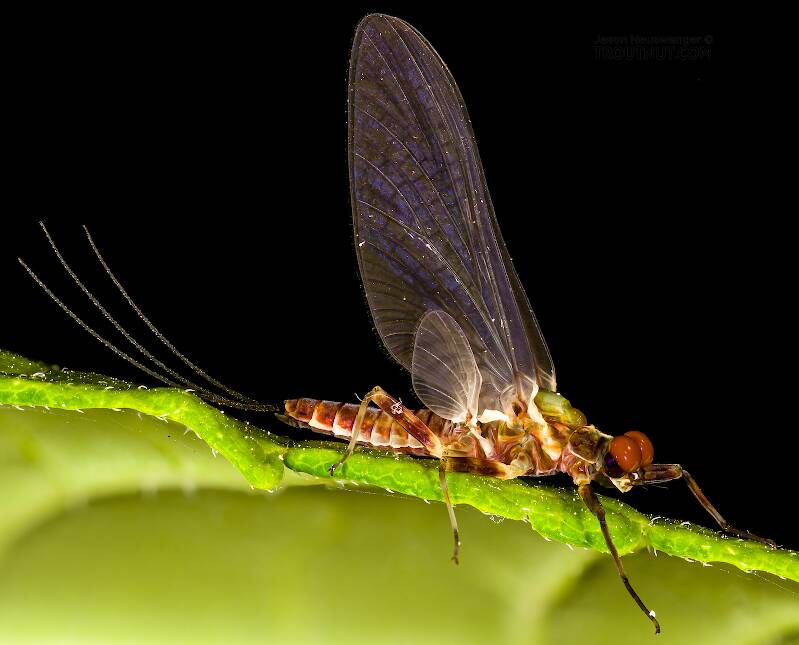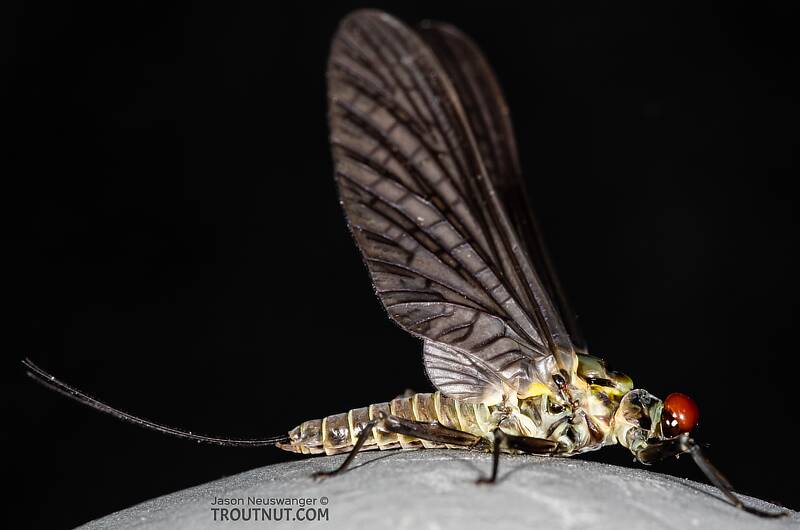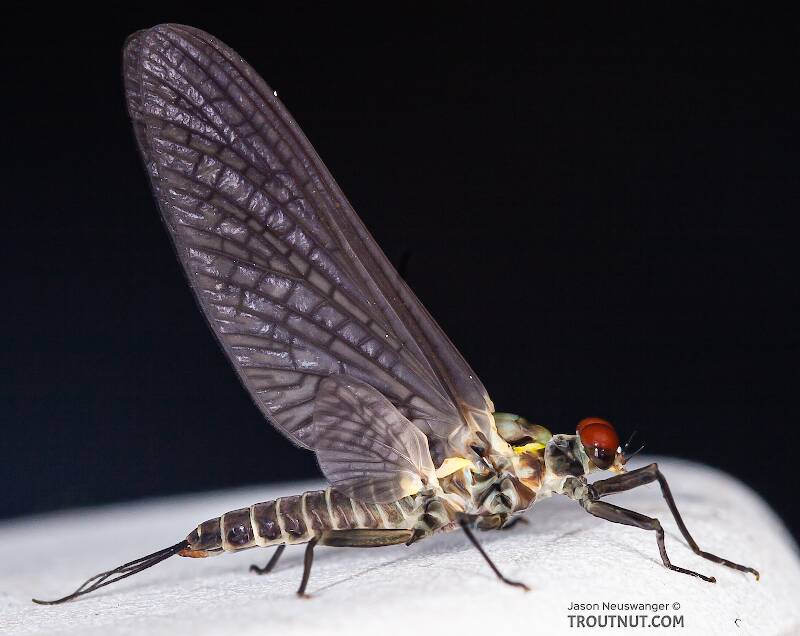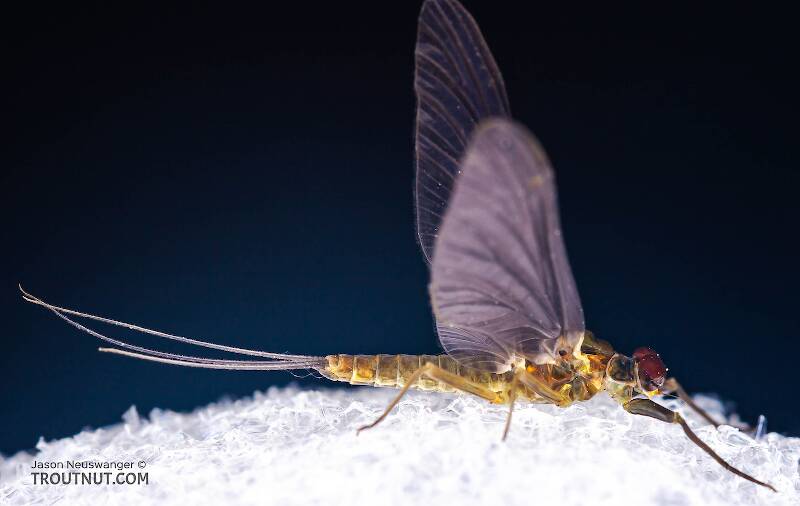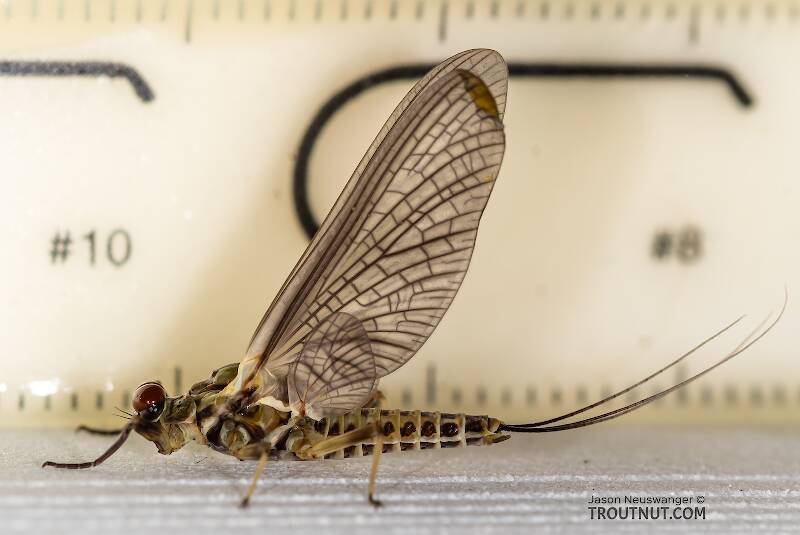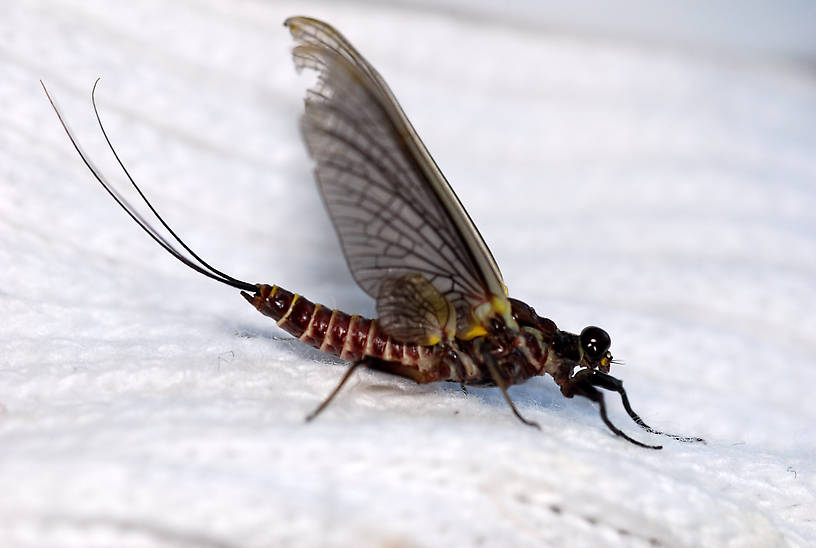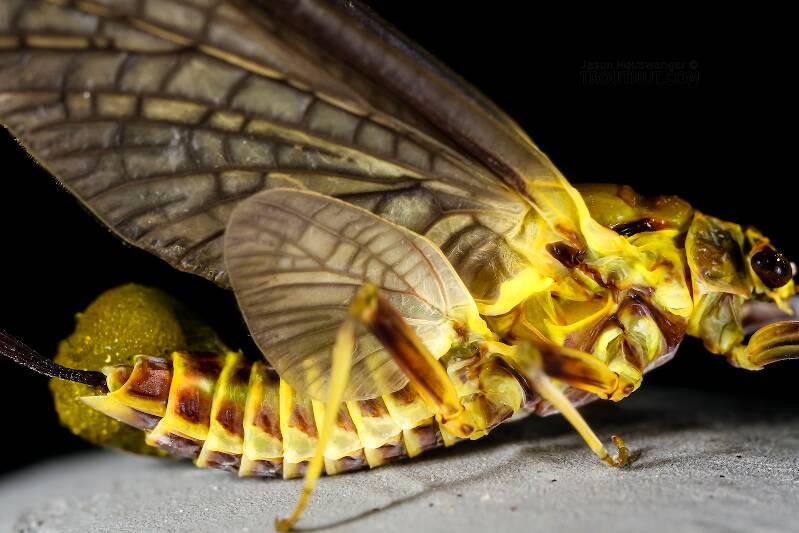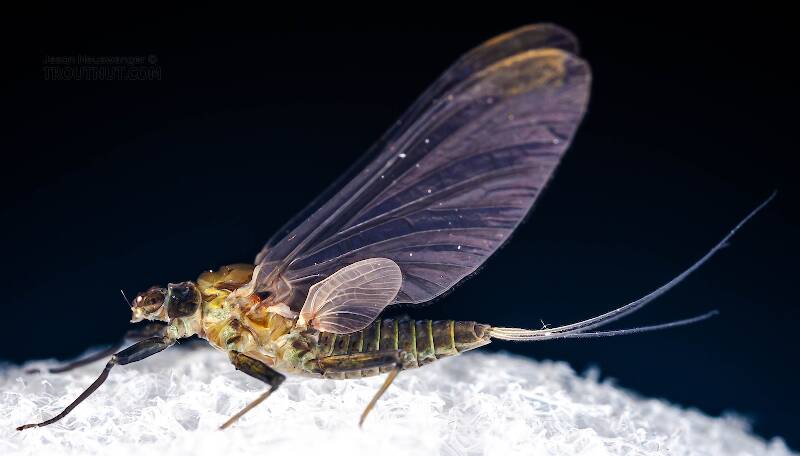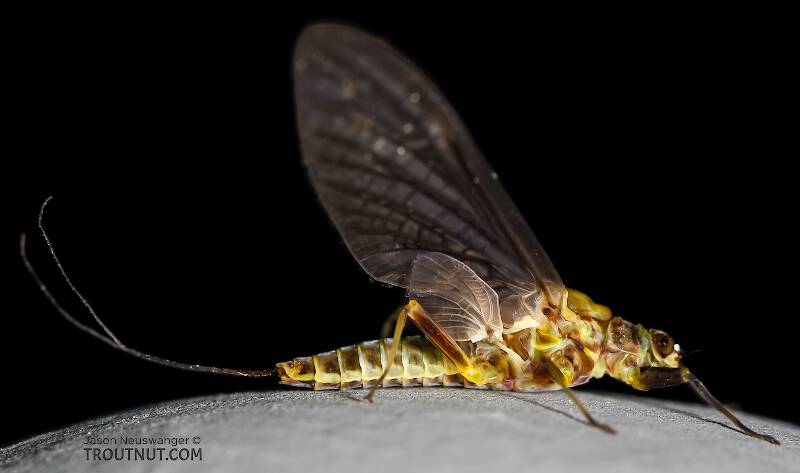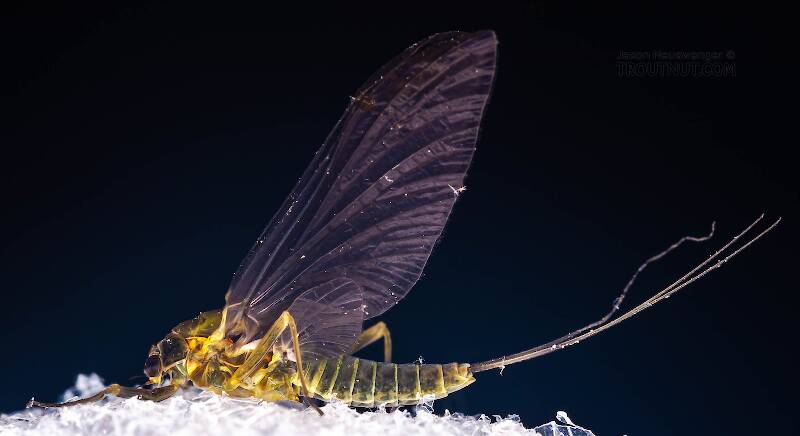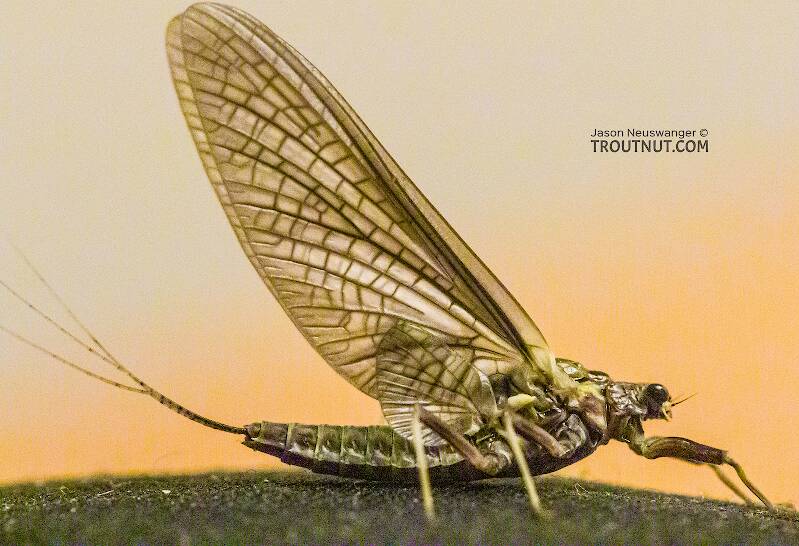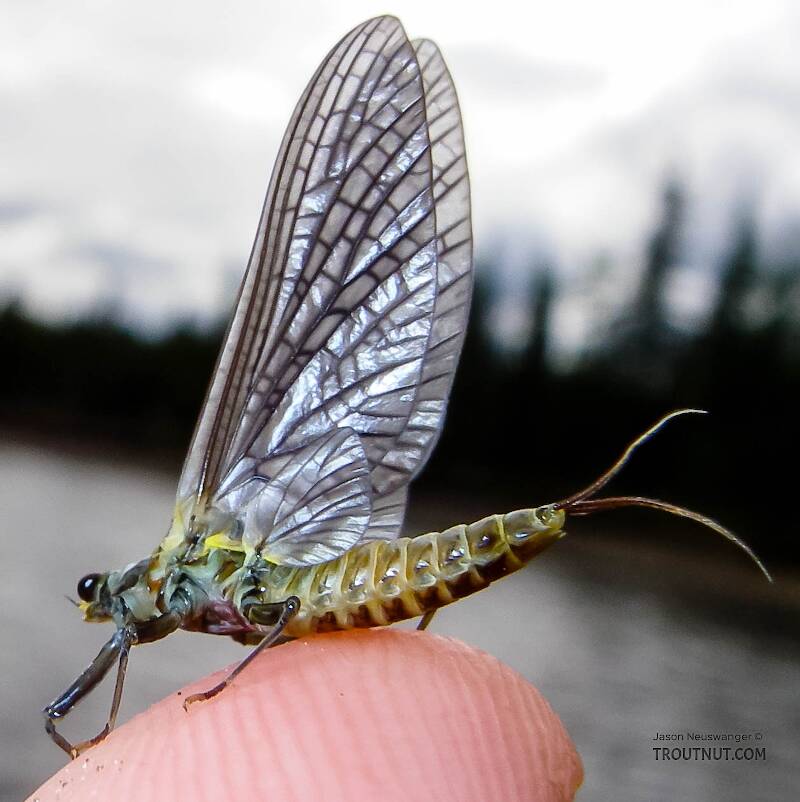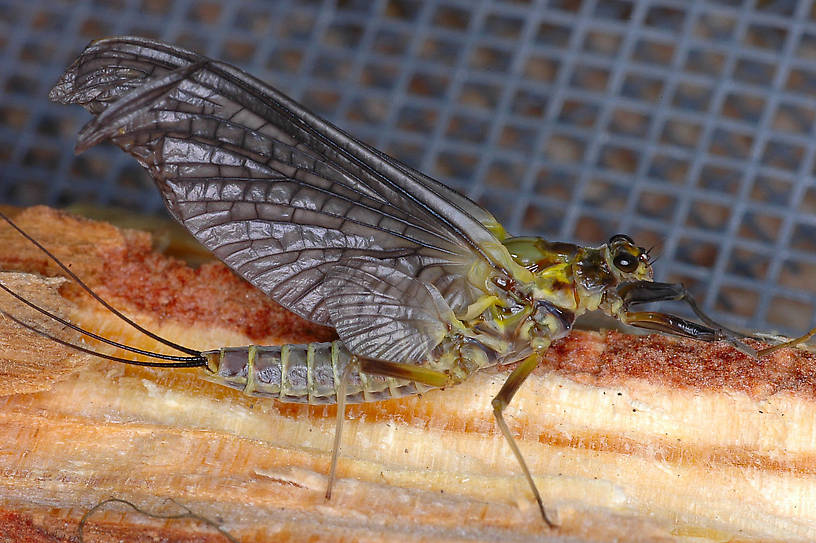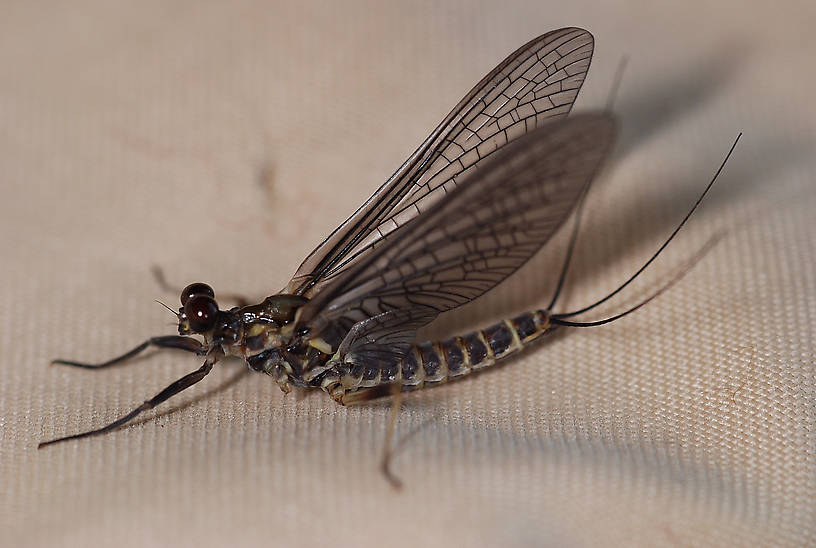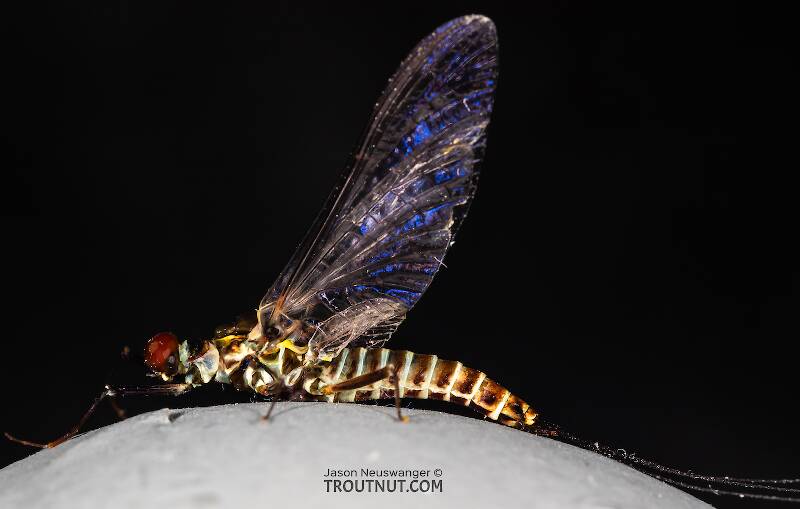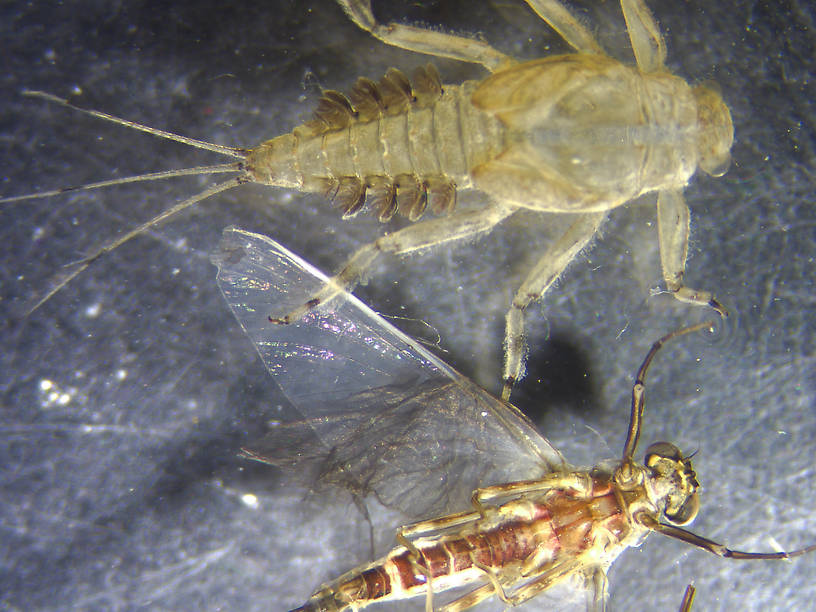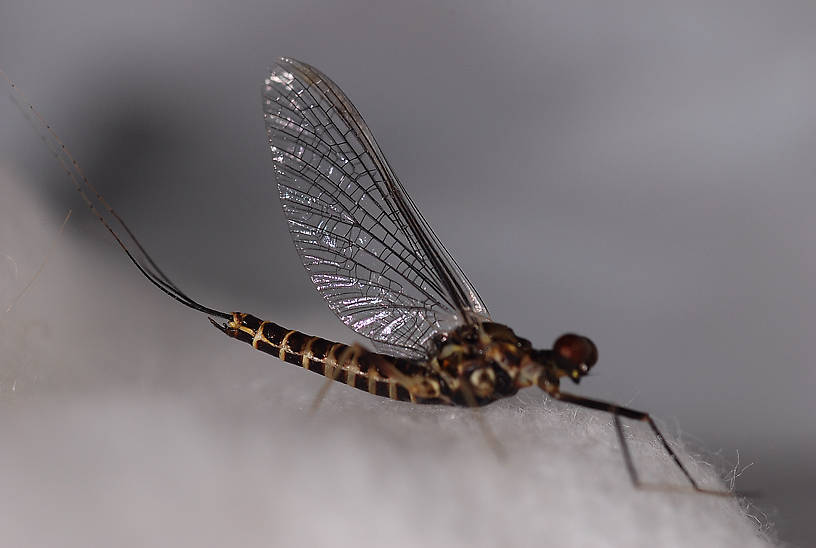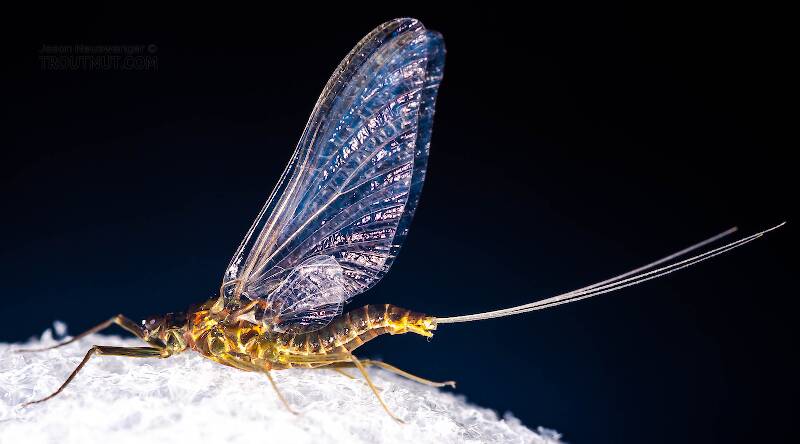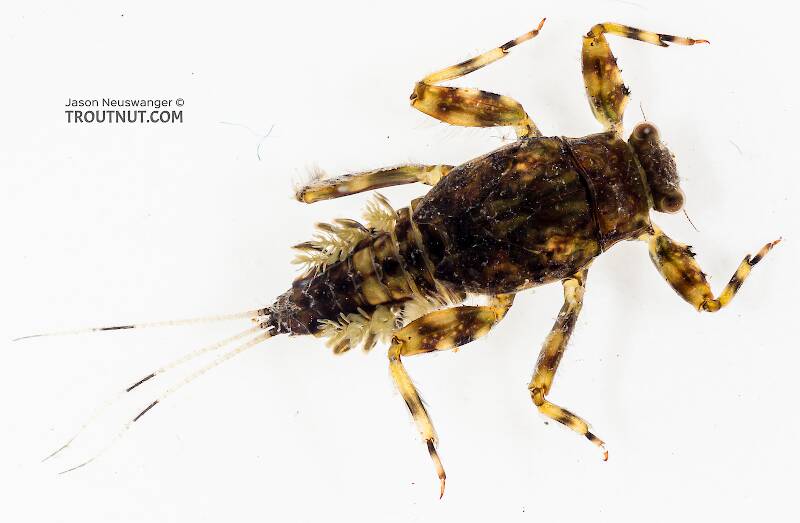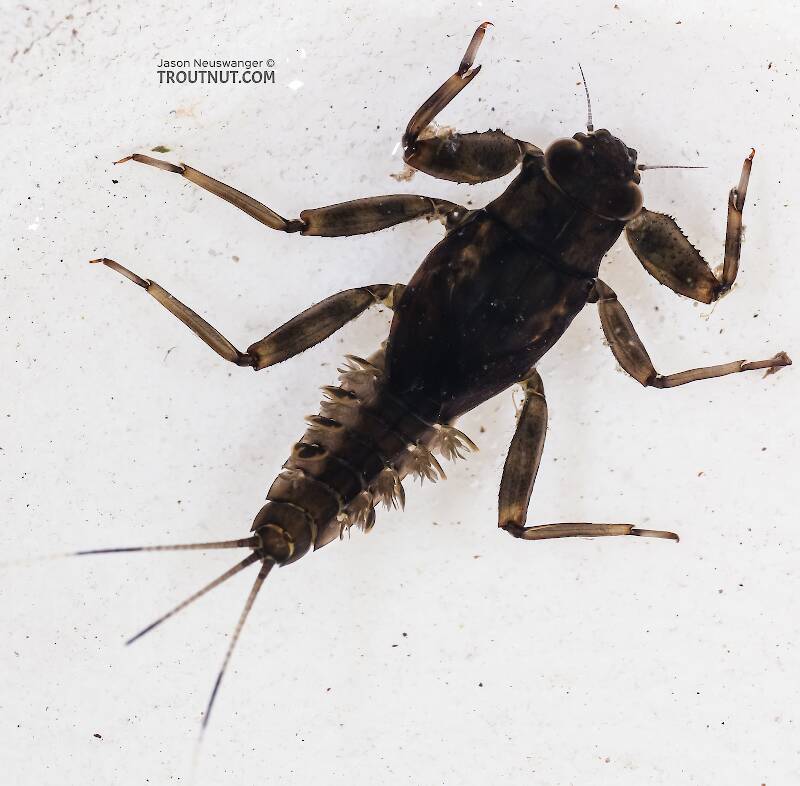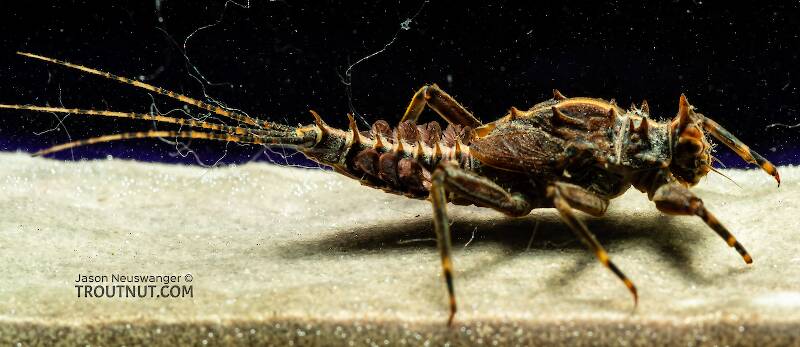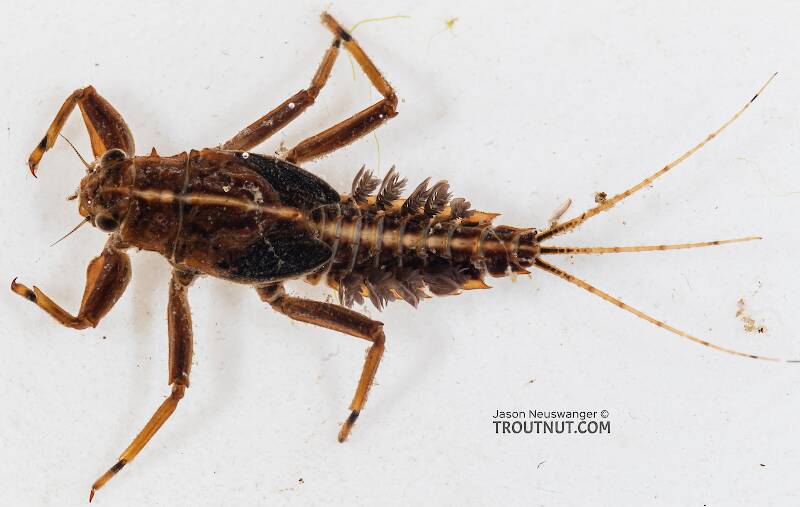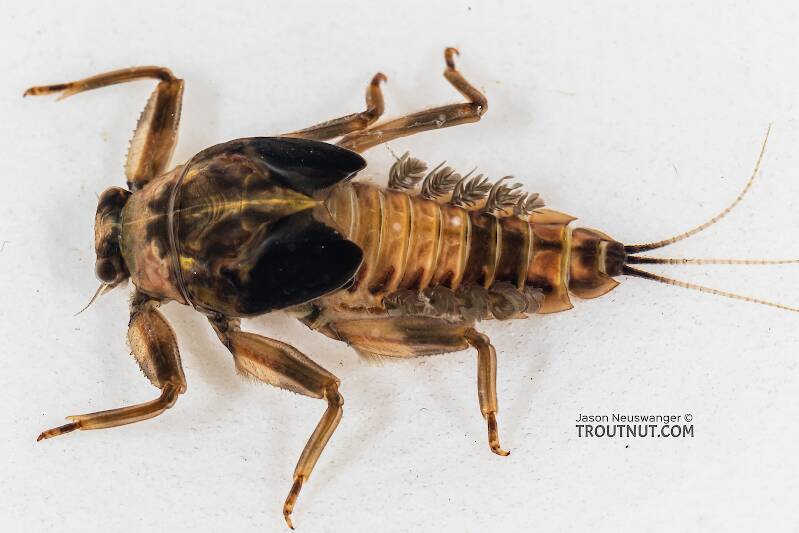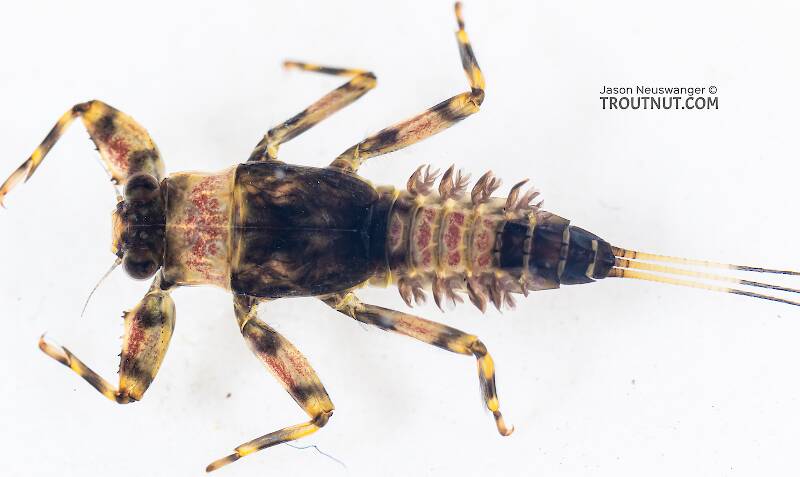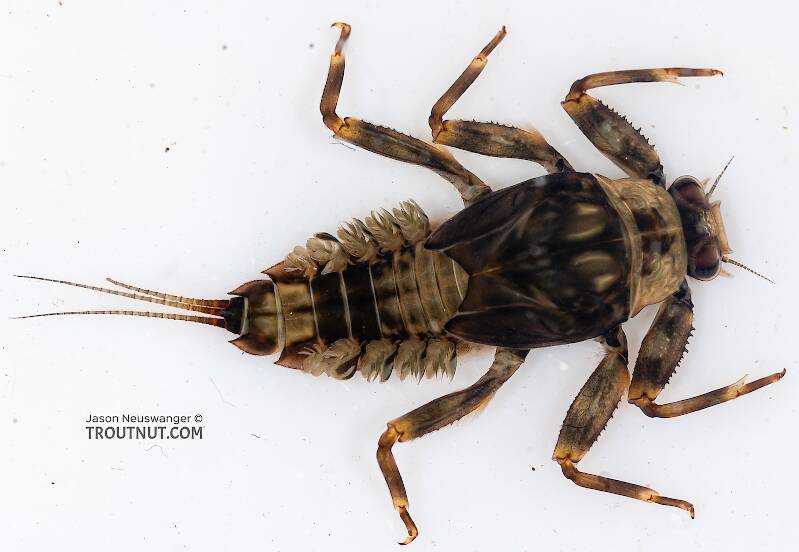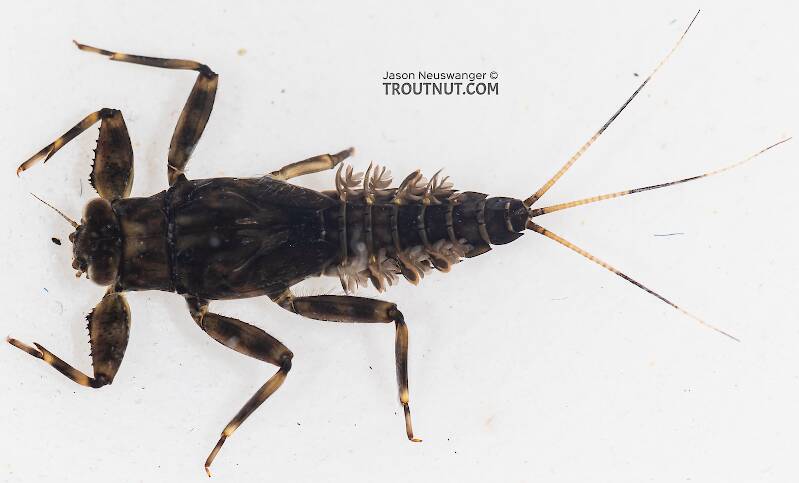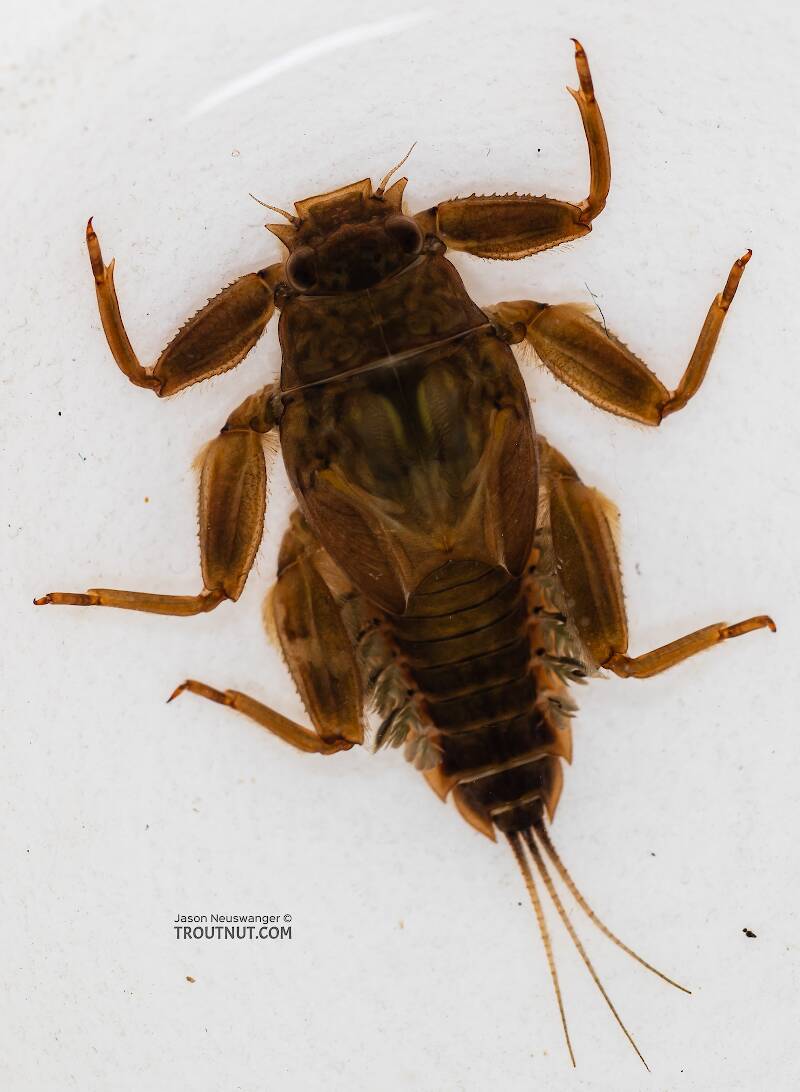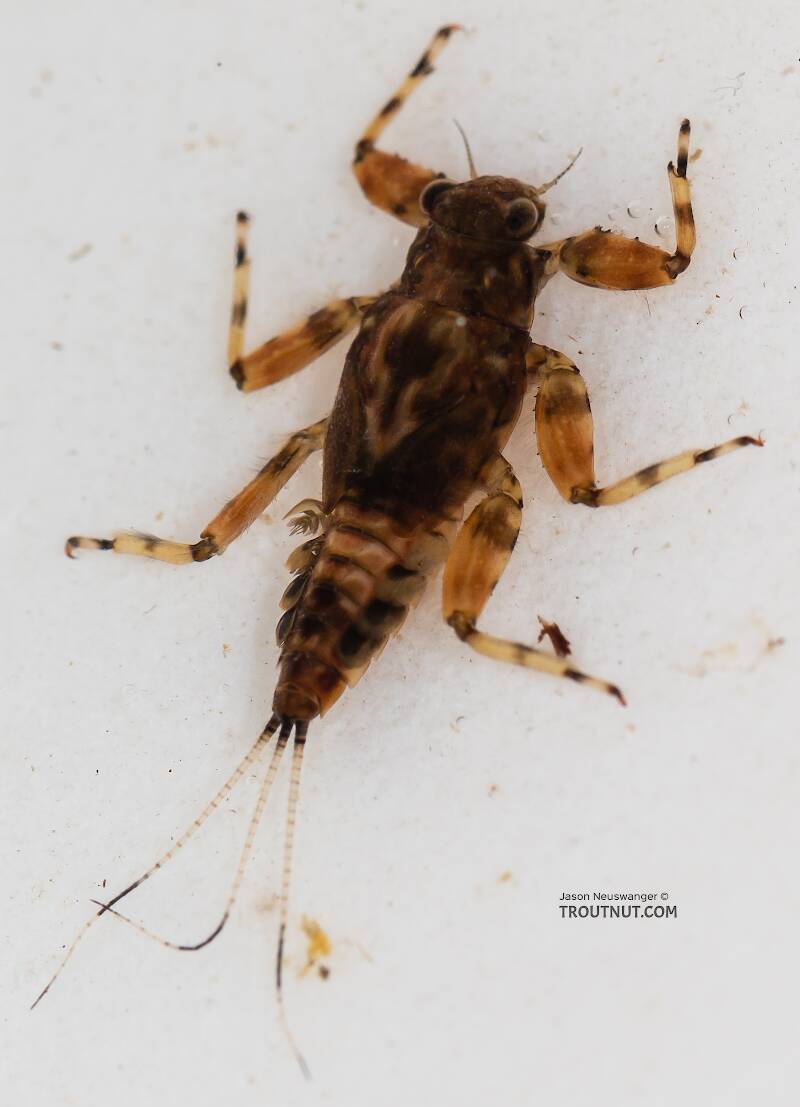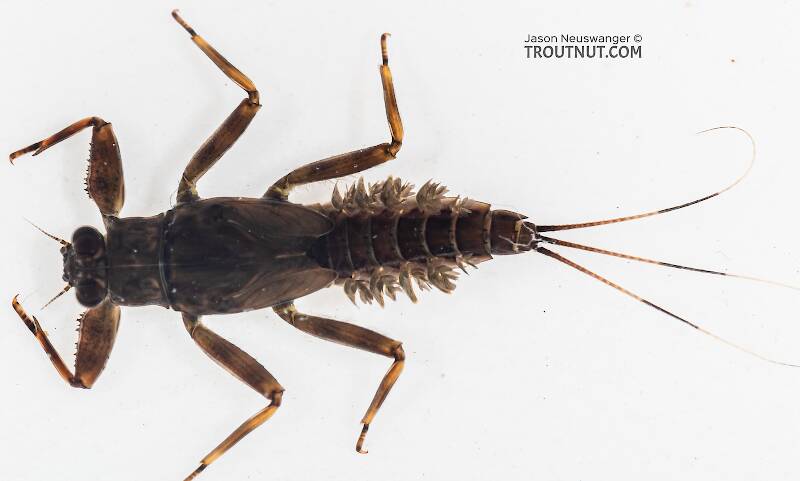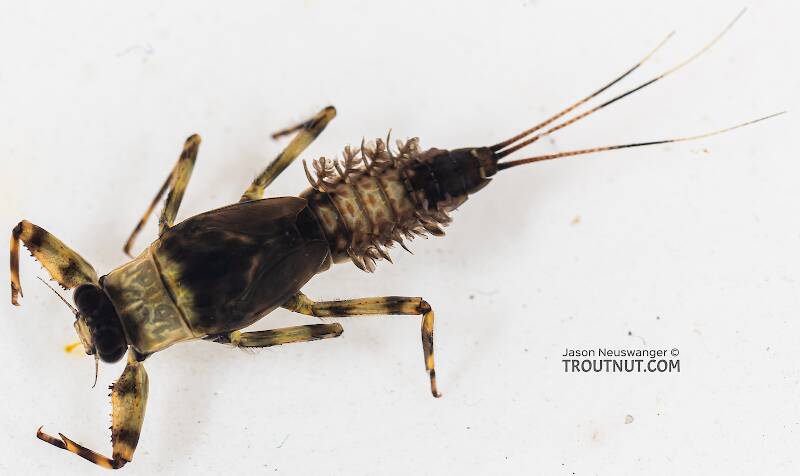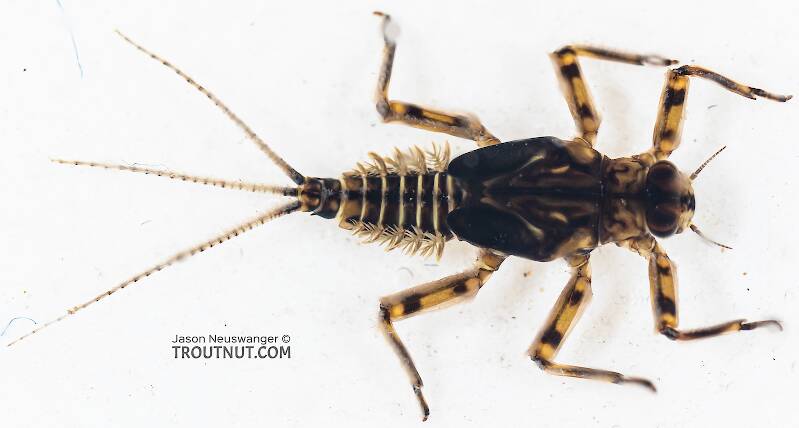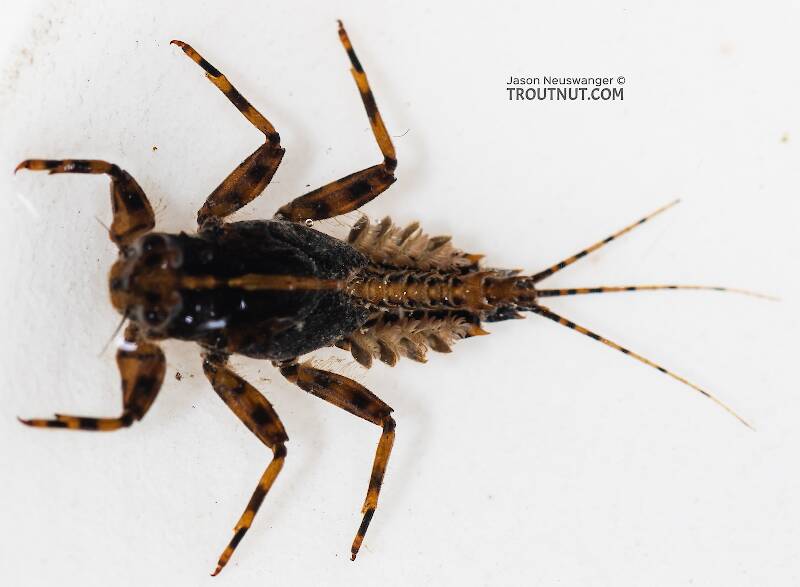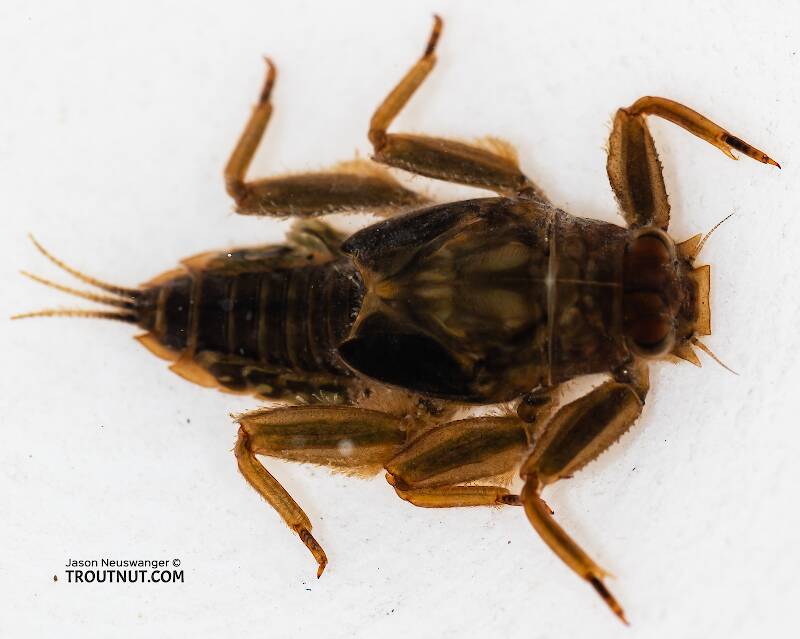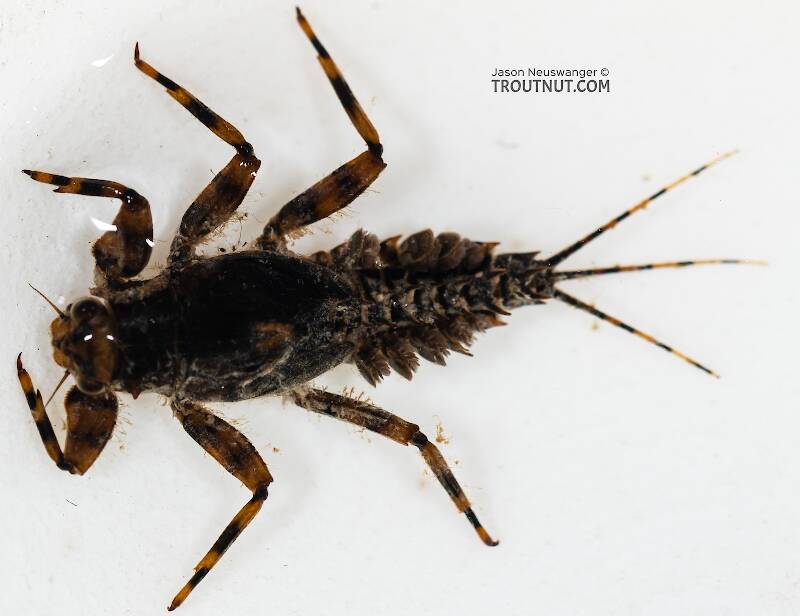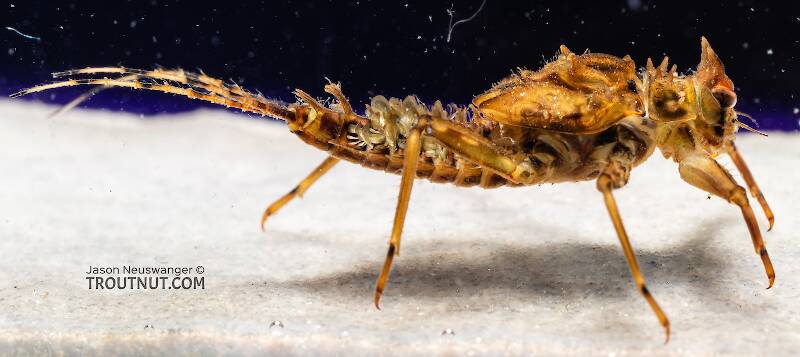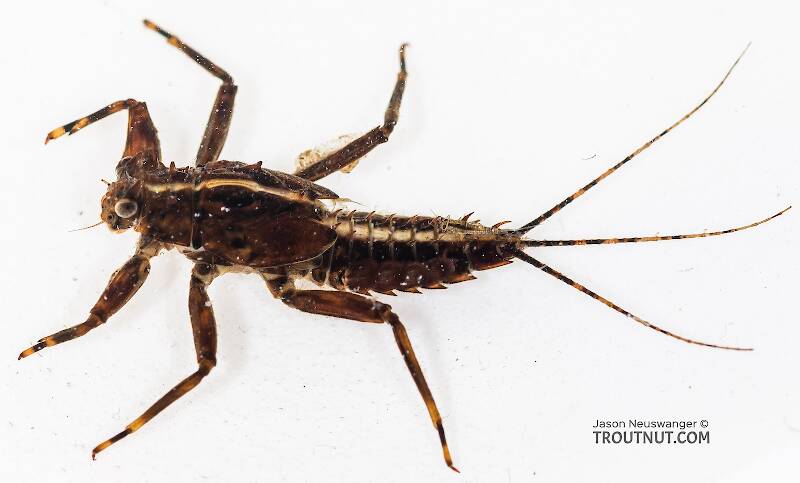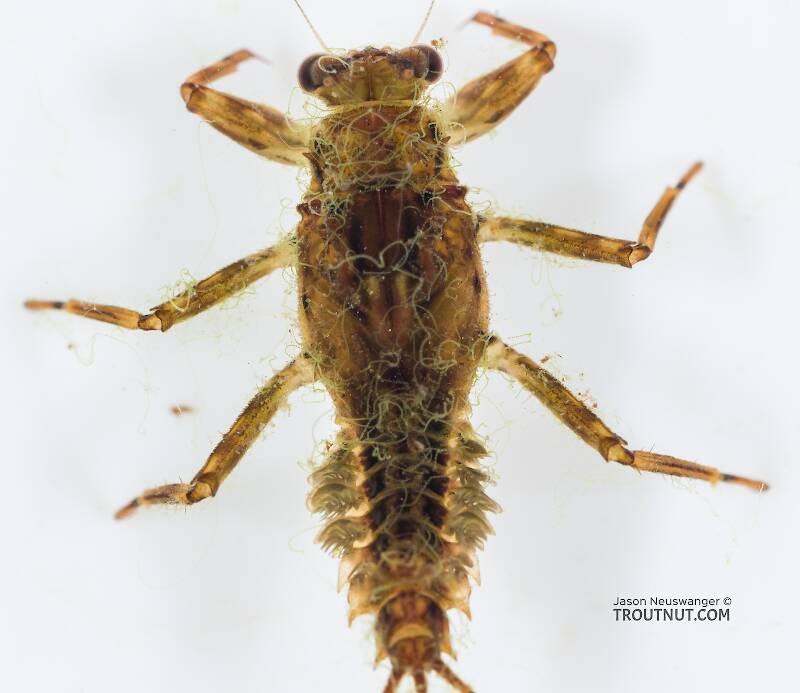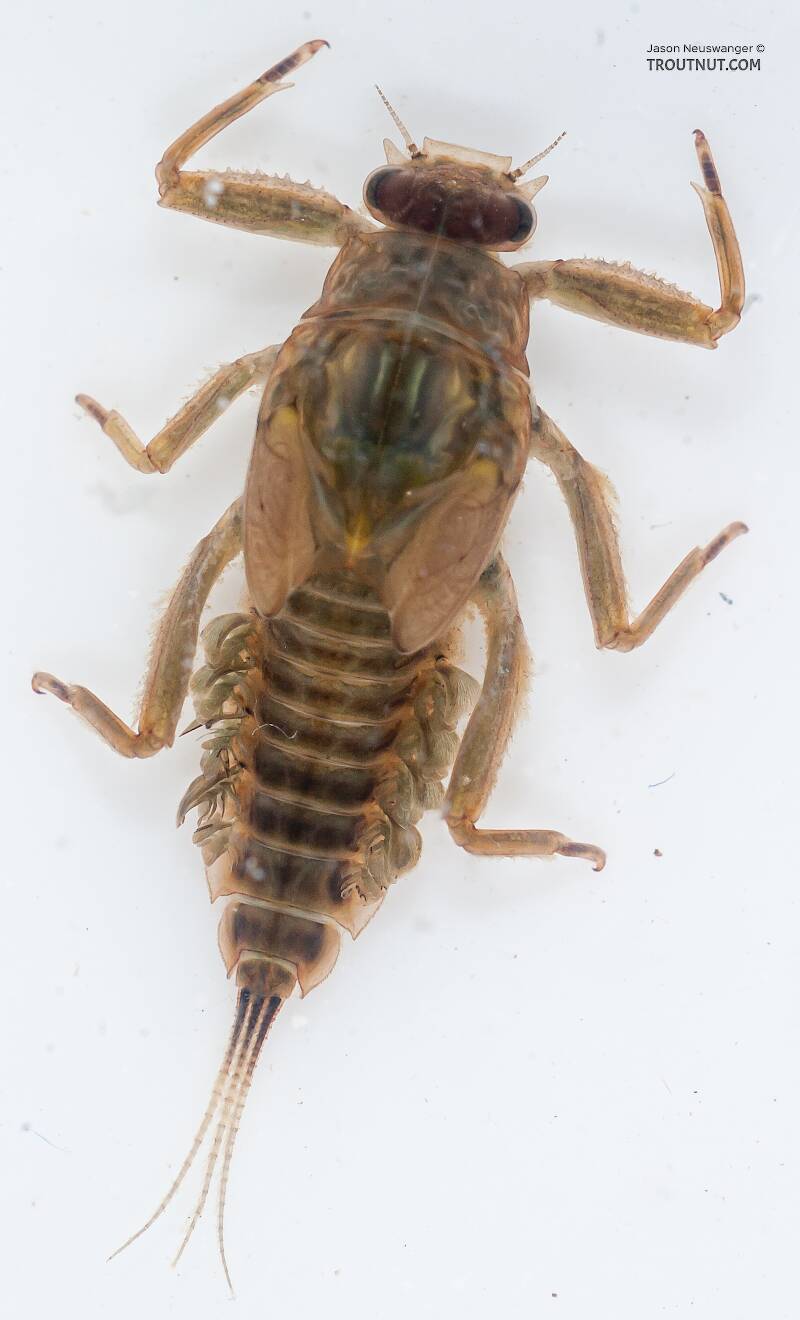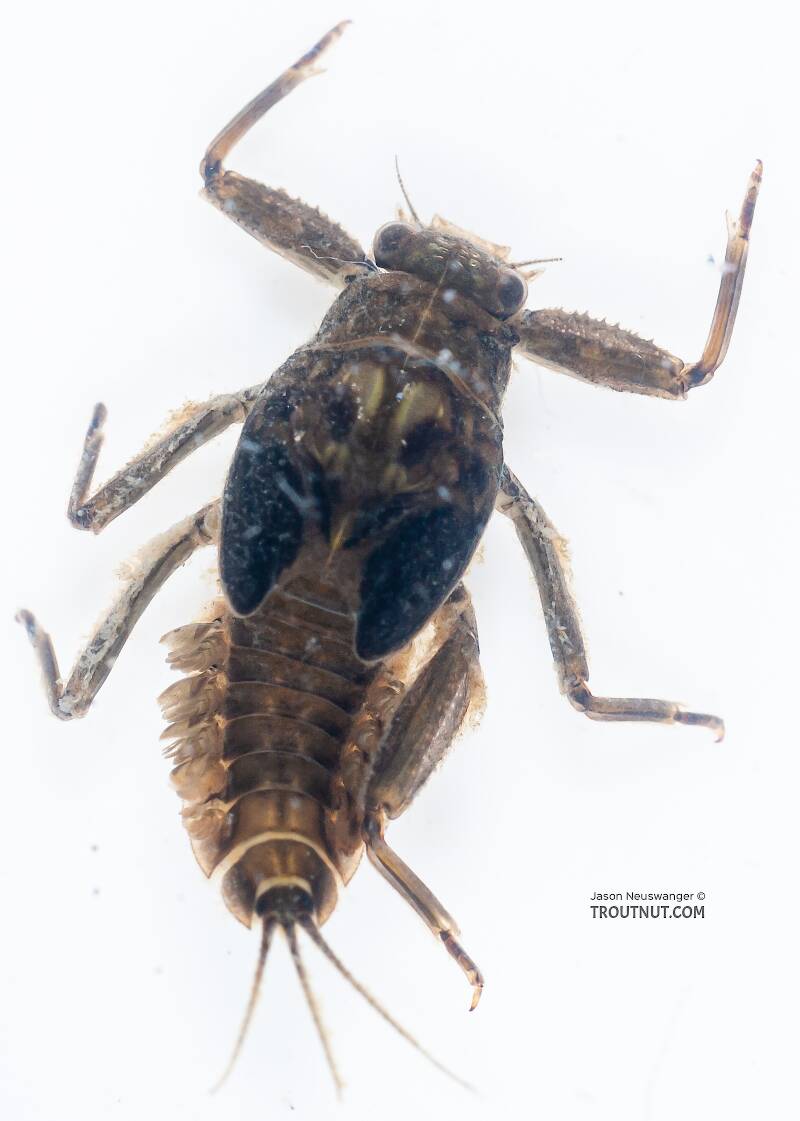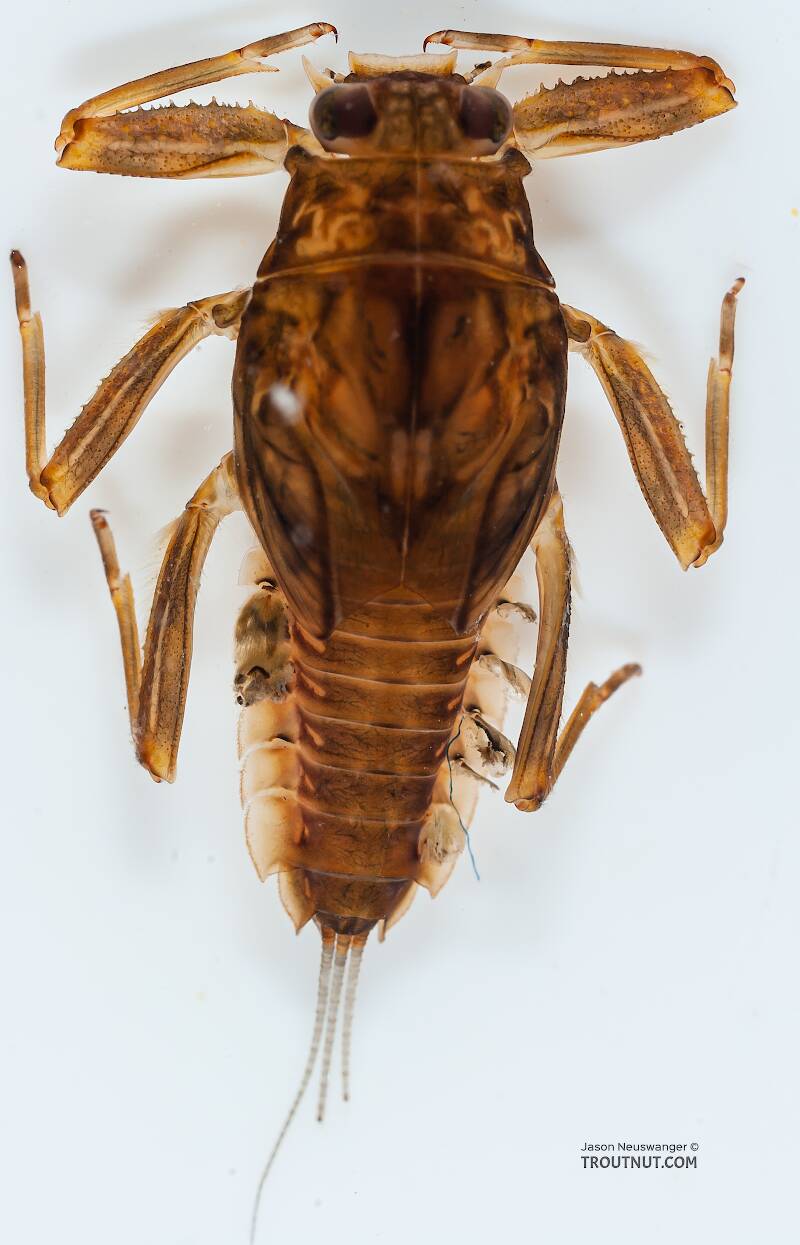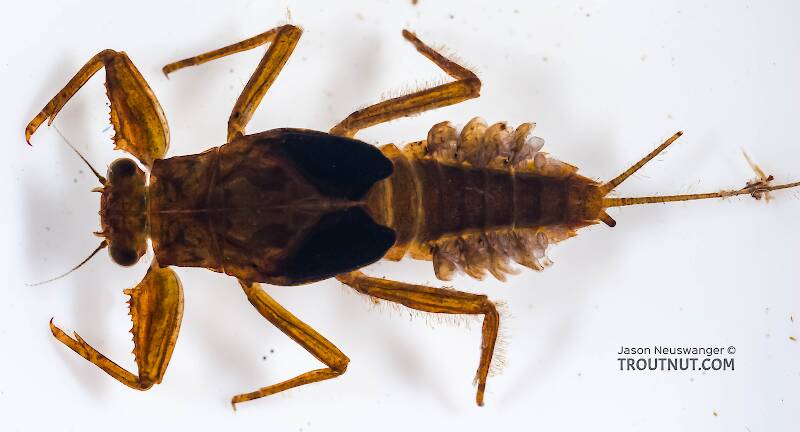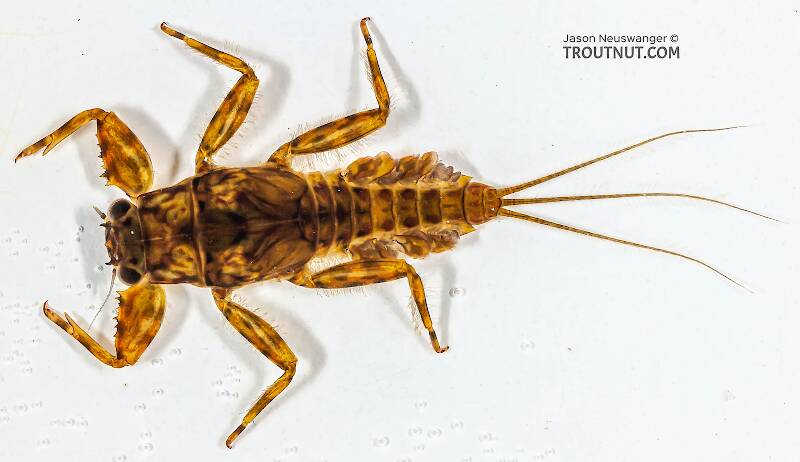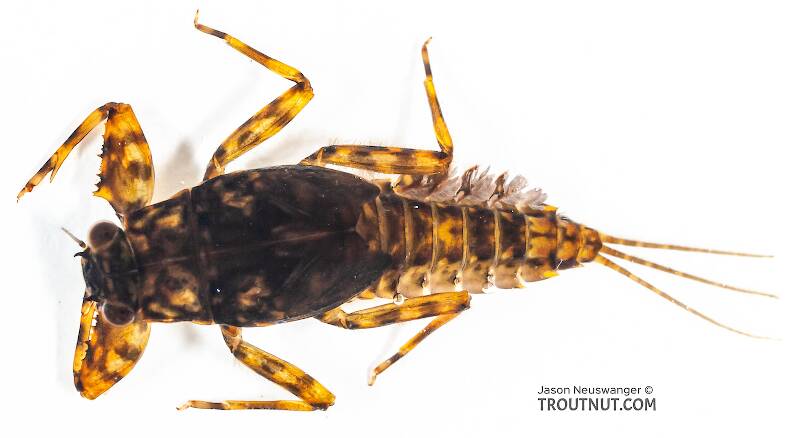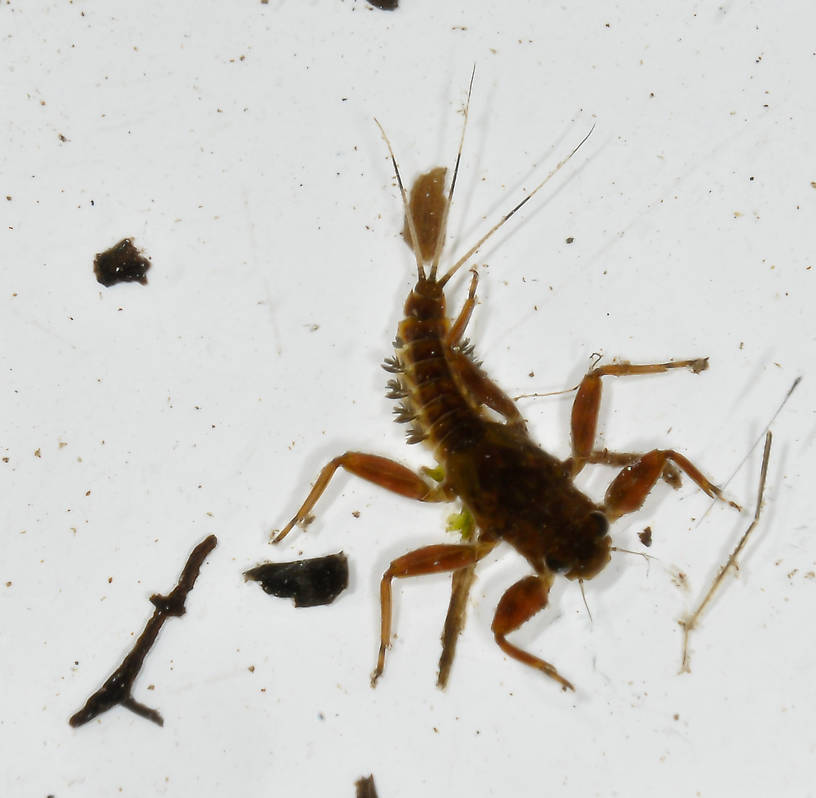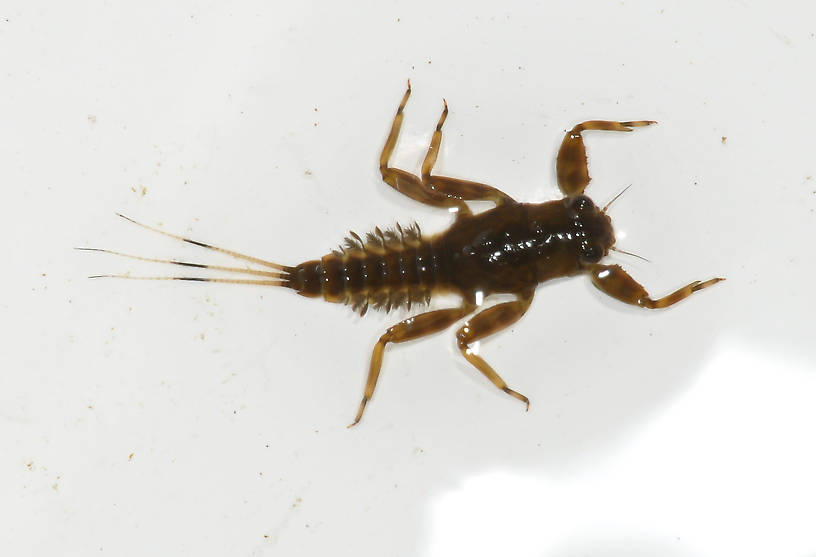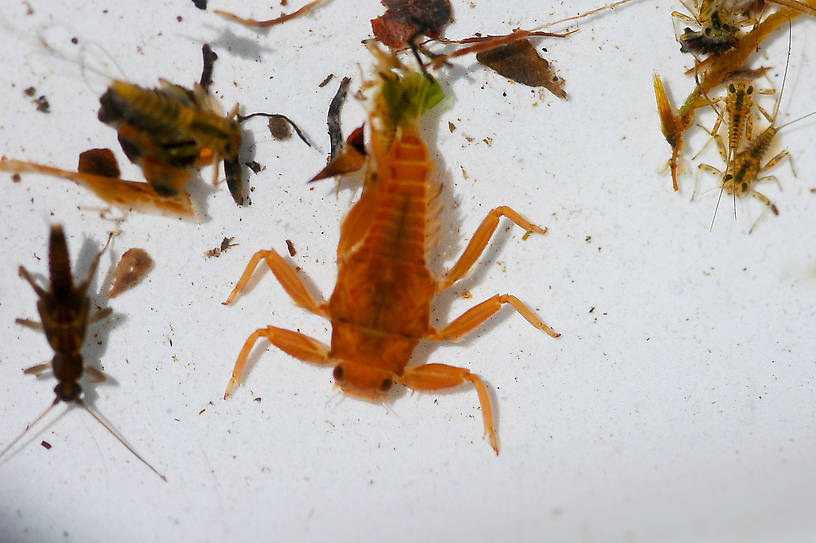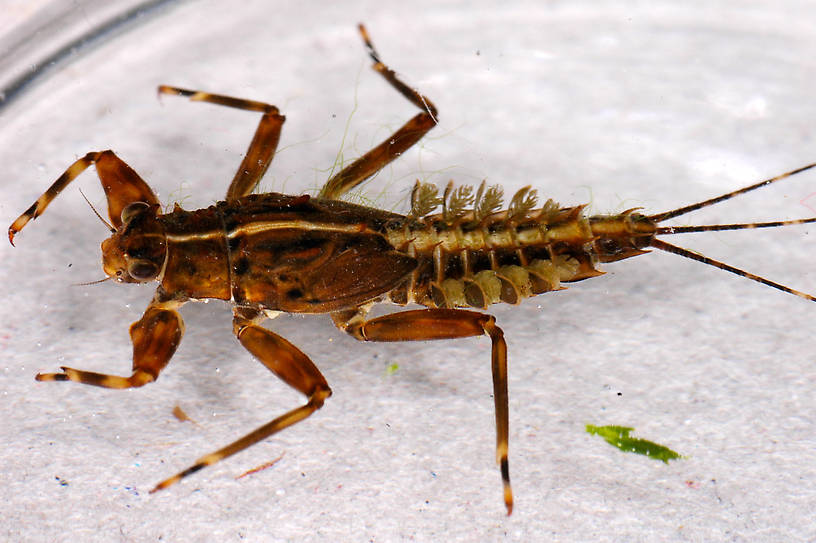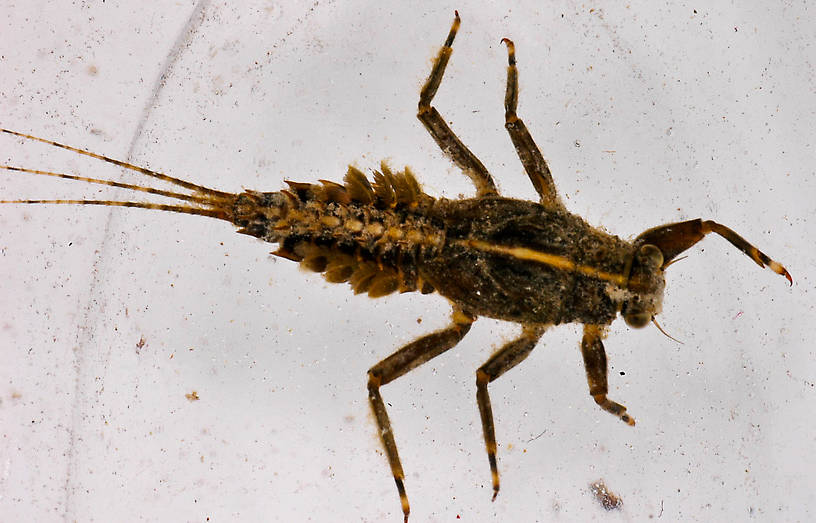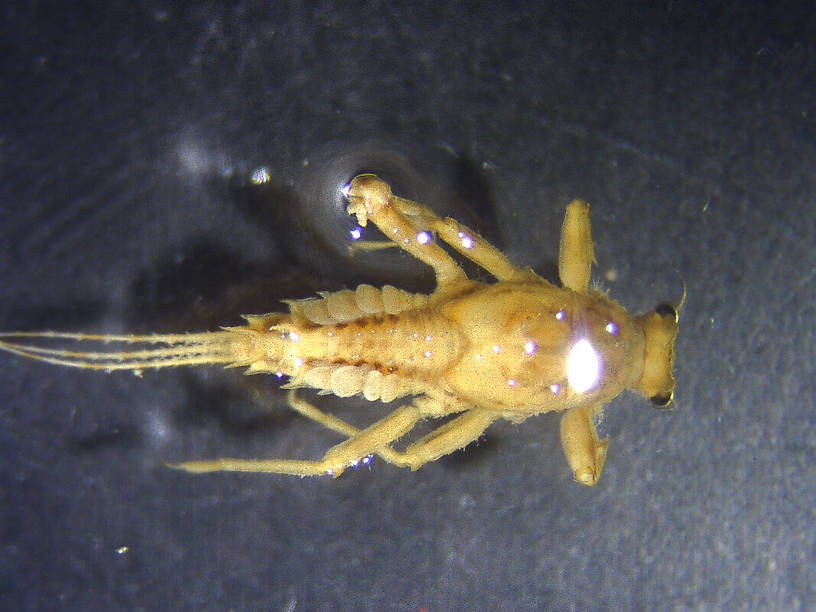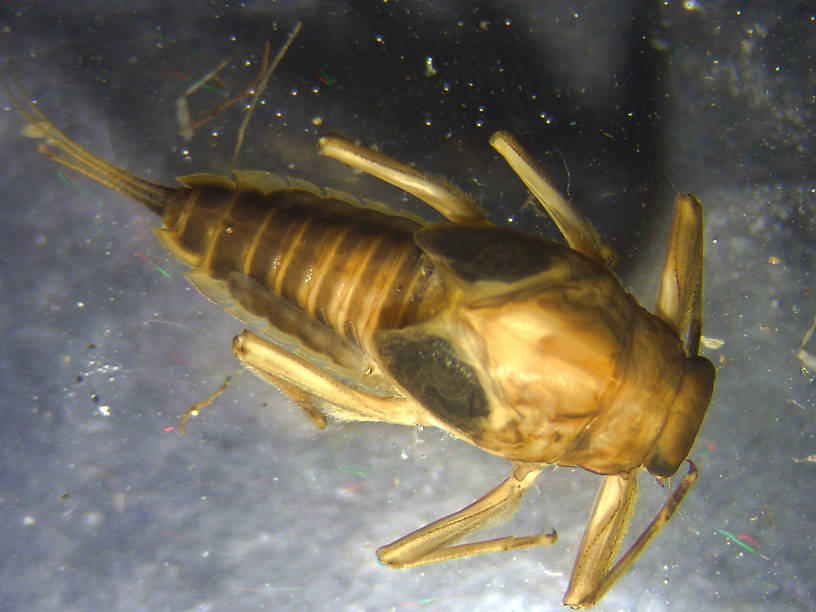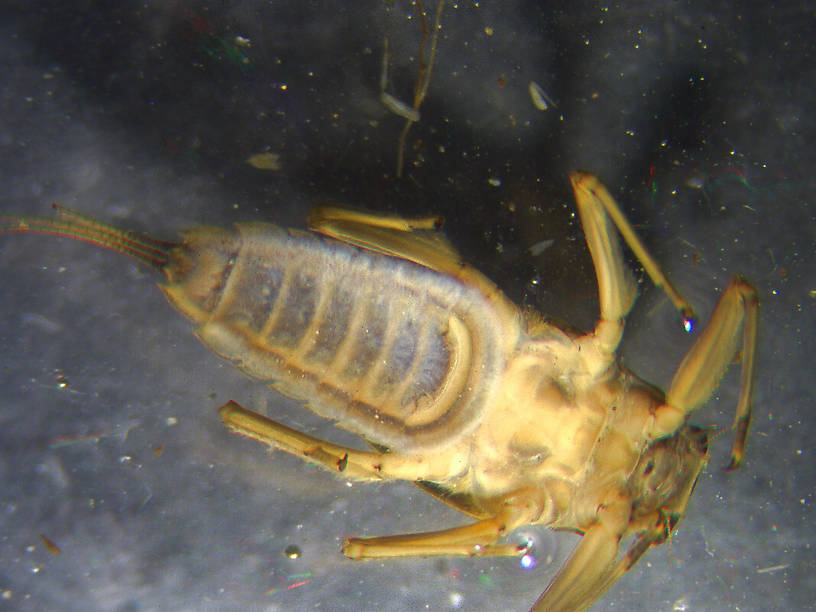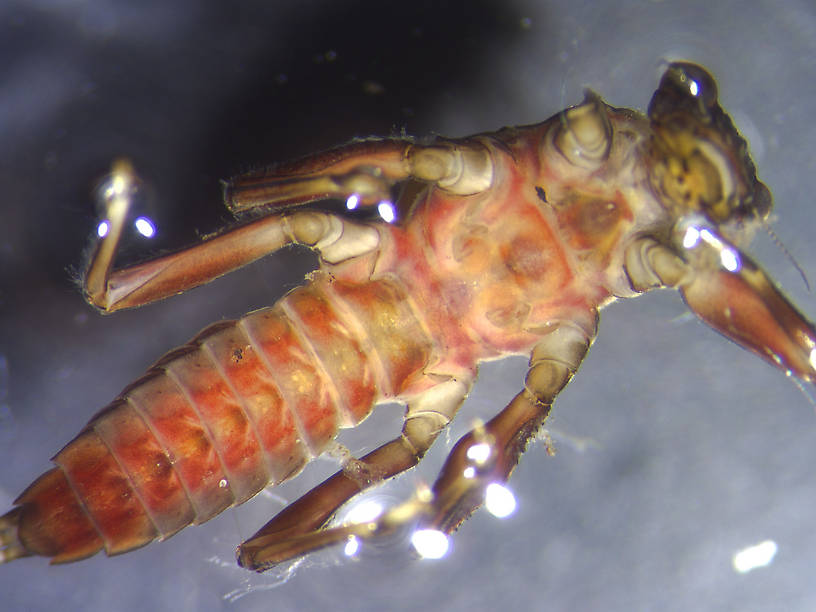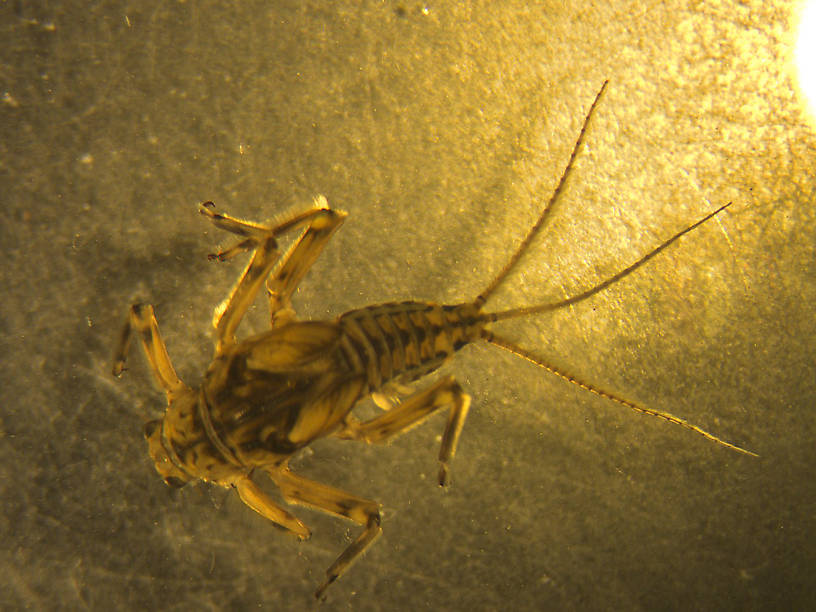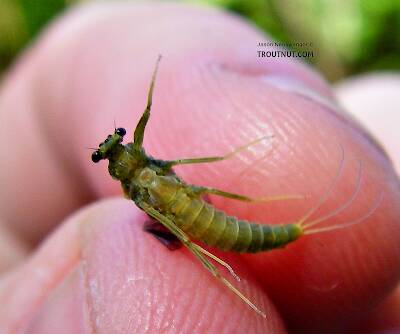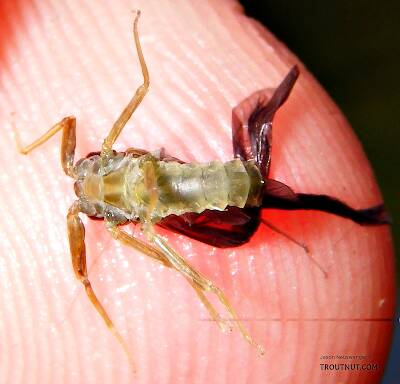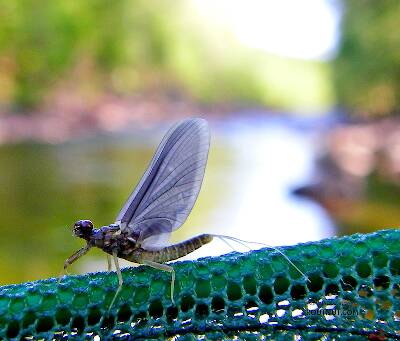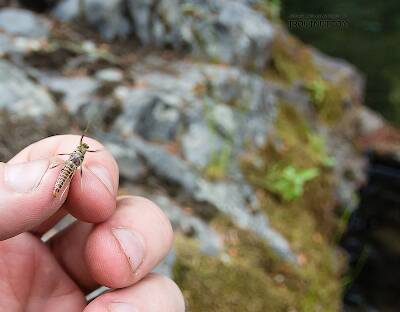
Blue-winged Olives
Baetis
Tiny Baetis mayflies are perhaps the most commonly encountered and imitated by anglers on all American trout streams due to their great abundance, widespread distribution, and trout-friendly emergence habits.
Featured on the forum

This wild-looking little thing completely puzzled me. At first I was thinking beetle or month larva, until I got a look at the pictures on the computer screen. I made a couple of incorrect guesses before entomologist Greg Courtney pointed me in the right direction with Psychodidae. He suggested a possible genus of Thornburghiella, but could not rule out some other members of the tribe Pericomini.

Troutnut is a project started in 2003 by salmonid ecologist Jason "Troutnut" Neuswanger to help anglers and
fly tyers unabashedly embrace the entomological side of the sport. Learn more about Troutnut or
support the project for an enhanced experience here.
Mayfly Genus Drunella (Blue-Winged Olives)
This genus contains most of the important Blue-Winged Olive ephemerellids that make up some very important hatches across the country.
In the East, there are the morning hatches of Drunella cornuta (Large Blue-Winged Olive) followed as the season progresses by the smaller Drunella cornutella and Drunella lata species, both commonly called Little Blue-Winged Olives. These hatches usually begin in late spring and can continue well into midsummer on many Eastern and Midwestern streams.
In the West, the Drunella genus is even more prominent. Besides having abundant Blue-Winged Olive hatches represented by the common species Drunella coloradensis (Little Western Green Drake), Drunella spinifera (Western Slate-winged Olive Dun) and Drunella flavilinea (Western Blue-winged Olive or "Flav") the region also has the Drunella group of famous Western Green Drakes made up of the curious flat-faced nymph species Drunella doddsii and the three subspecies of Drunella grandis. Coloration ranges widely by region, going from dark brown to bright green. Most commonly they will be in the olive range. The wings too can range from dark slate to medium dun, often with yellow or olive pigment in the basal costal region (lower leading edge) of the forewings.
There have been many changes in taxonomic nomenclature affecting the Ephemerellidae over the years with few impacted more than the species of this genus. Anglers interested in "connecting the dots" with entomological information provided in fishing literature of the past need to take note of this.
In the East, there are the morning hatches of Drunella cornuta (Large Blue-Winged Olive) followed as the season progresses by the smaller Drunella cornutella and Drunella lata species, both commonly called Little Blue-Winged Olives. These hatches usually begin in late spring and can continue well into midsummer on many Eastern and Midwestern streams.
In the West, the Drunella genus is even more prominent. Besides having abundant Blue-Winged Olive hatches represented by the common species Drunella coloradensis (Little Western Green Drake), Drunella spinifera (Western Slate-winged Olive Dun) and Drunella flavilinea (Western Blue-winged Olive or "Flav") the region also has the Drunella group of famous Western Green Drakes made up of the curious flat-faced nymph species Drunella doddsii and the three subspecies of Drunella grandis. Coloration ranges widely by region, going from dark brown to bright green. Most commonly they will be in the olive range. The wings too can range from dark slate to medium dun, often with yellow or olive pigment in the basal costal region (lower leading edge) of the forewings.
There have been many changes in taxonomic nomenclature affecting the Ephemerellidae over the years with few impacted more than the species of this genus. Anglers interested in "connecting the dots" with entomological information provided in fishing literature of the past need to take note of this.
Genus Range
Hatching behavior
Like the rest of the Ephemerellidae, they are classic surface emergers with long sedate floats in optimal weather and often engage in "practice runs" exposing the nymphs to trout during extended pre-hatch periods. But more so than others, this genus seems to have a greater propensity to emerge subsurface somewhere in the top 12 inches of water even in slower currents. They often arrive on the surface bedraggled and ride its currents for a long time before their wings are ready for flight.Some species in this genus tend to change color dramatically as soon as they hit the air, and it's often important to imitate the bright greens the trout see in the "fresh" duns rather than the muted shades of olive or ruddy brown that we find when collected later.
Spinner behavior
The spinners (imagos) of this group are typically various shades of brown or darker versions of the duns (subimagos) with clear glassy wings. Their egg masses are typically very dark olive to almost black which is another identifying characteristic separating them from all but a few important Ephemerellidae. The spinner falls can be important or unimportant, depending on species, location and circumstances.Nymph biology
Diet: Herbivorous; Carnivorous?
Identification
To further identify a specimen of Drunella to the species level, use the Key to Species of Drunella Nymphs.
Specimens of the Mayfly Genus Drunella
6 Male Duns
8 Female Duns
3 Male Spinners
1 Female Spinner
35 Nymphs
4 Streamside Pictures of Drunella Mayflies:
Discussions of Drunella
Drunella cornuta on the Brodhead at Stroudsburg PA
11 replies
Posted by Reify on Apr 21, 2014 in the species Drunella cornuta
Last reply on Apr 24, 2014 by Brookyman
4/21/14 - Fished the Brodhead today at the last park before last bridge on PA 191 - downstream of huge riffle section so is a great tretch for this species. I didn't get there until around 1:00 PM, took a nap and started fishing at 2:00 and there were still cornuta coming off sparsely but steadliy - until 3:30 PM. Sparse rises, but I was entertained. Is that normal or could it be because the water is unusually cold this year. Are the males and females of the same size or is one larger - and of slightly more pale coloration at take-off from surface? It almost looked to me to be two different flies, but I'm sure they weren't.
Drunella in the Smokies
6 replies
Posted by Konchu on Sep 20, 2009 in the species Drunella tuberculata
Last reply on Jan 4, 2010 by Konchu
Just got back from a trip to the North Carolina side of the Smokies. Drunella tuberculata (probably the conestee form) is getting ready to hatch there. Most of the other bugs of decent size that I saw were relatively young.
Midwest Lata Emergence
20 replies
Posted by DarkDun on Mar 4, 2007 in the species Drunella lata
Last reply on May 2, 2007 by Taxon
The D.Lata emerges in Michigan waters at 10 AM on the dot and stops at noon from about June 25 thru July 10. I have fished this hatch avidly for years and find it very punctual on moderately overcast days. Sunny days make it much shorter duration, about 30 minutes. A size 14 imitates it perfectly with dark dun wings, bright olive green body and med dun tails and legs at emergence. The body color does change to dark green after a while.
The D.Lata also is significant in PA Northern Streams in Mid May.
I have not encountered it in the South Appallacian streams as yet. I fish some smaller BWO (#16-20) in NC but none so large as D. Lata.
The D.Lata also is significant in PA Northern Streams in Mid May.
I have not encountered it in the South Appallacian streams as yet. I fish some smaller BWO (#16-20) in NC but none so large as D. Lata.
Start a Discussion of Drunella
References
- Arbona, Fred Jr. 1989. Mayflies, the Angler, and the Trout. Nick Lyons Books.
Mayfly Genus Drunella (Blue-Winged Olives)
Taxonomy
Species in Drunella
Drunella allegheniensis
0
0
Drunella coloradensisSmall Western Green Drakes
10
52
Drunella cornutaLarge Blue-Winged Olives
6
36
Drunella cornutellaSmall Blue-Winged Olives
0
0
Drunella doddsiiWestern Green Drakes
12
63
Drunella flavilineaFlavs
5
31
Drunella grandisWestern Green Drakes
12
66
Drunella lataSmall Blue-Winged Olives
0
3
Drunella longicornis
0
0
Drunella pelosa
2
9
Drunella spiniferaWestern Slate Olive Duns
4
15
Drunella tuberculata
1
14
Drunella walkeriLarge Blue-Winged Olives
0
0

